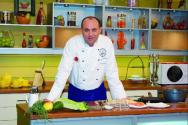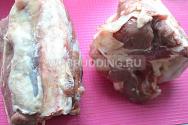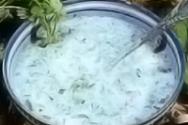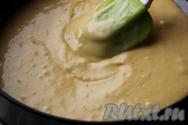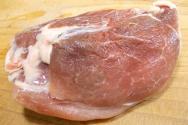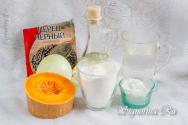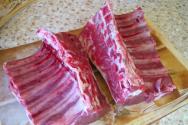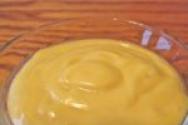Tests on the topic of biscuit dough. Biscuit dough. Sponge cake with apples
To use presentation previews, create a Google account and log in to it: https://accounts.google.com
Slide captions:
Lesson topic: Preparation of biscuit dough and products made from it Prepared by: Master p / o - KANGASH O. A.
Test task (completion time - 5 minutes) No. QUESTION OPTIONS OF ANSWERS 1 The main method of heat treatment used in the preparation of confectionery products a) boiling b) baking c) baking 2 The method of heat treatment used in the preparation of semi-finished wafer product: a) main b) contact c) combined 3 Gluten is a) Soluble proteins b) Proteins swollen in water c) Gelatinized starch 4 The absence of which product contributes to the friability of shortcrust pastry products: a) water b) fat c) eggs 5 The method of loosening used in shortcrust pastry test: a) biological b) mechanical c) chemical
No. QUESTIONS OPTIONS OF ANSWERS 6 What will happen to the dough if you increase the kneading time: a) it will become liquid; b) will drag on; c) nothing will happen. 7 Baking temperature for shortcrust pastry: a) 260 – 270 ˚С b) 190 – 220 ˚С c) 200 – 210 ˚С 8 To prepare shortcrust pastry, use flour: a) with a high gluten content; b) low gluten content; c) second class. Complete sentence 9 The consistency of the waffle dough is similar to the dough ………………………………………………………………………………………… ……………………… ………………………………………………………… 10 Tempering is………………………………………………………… …… ………………………………………………………………………………….
Standard answers 1 2 3 4 5 6 7 8 9 10 V B B A V B A B for pancakes, uncooked places inside the products
Evaluation criteria from 1 to 8 – 1 point, 9,10 – 2 points, Maximum number of points – 12 points
Lesson objectives: To develop knowledge about the features and methods of preparing biscuit dough, methods of molding and baking products from this dough.
WHAT MAIN PRODUCTS ARE NEEDED FOR PREPARING BISCUIT DOUGH?
Essence
Main raw materials Flour Peso sugar Eggs Starch essence
Additional raw materials cocoa, coffee, nuts, vegetables, butter
Combine eggs with granulated sugar and, stirring, heat in a water bath to 45 o C
Beat the egg-sugar mixture until the volume increases 2.5-3 times and until a stable pattern appears on the surface, cool to 20 o C
The flour is combined with starch and quickly (but not abruptly) mixed with the egg-sugar mass. At the end of the kneading, add essence.
The finished biscuit dough is baked in capsules, on baking sheets or molds at a temperature of 200-210 o C for 10-30 minutes, depending on the form used.
Baking dishes
The end of the baking process is determined by the light brown color of the crust and elasticity. The baked sponge cake is cooled and, using a thin knife, is cut along the entire perimeter of the sides of the mold and thrown onto the table.
Quality indicators Appearance Color Consistency Taste
Quality requirements: Appearance: a) shape – preserved, correct; b) surface - smooth c) crust color - light brown, crumb - yellow d) consistency - fluffy, porous; Taste – sweetish; Humidity – 25 ±3%
Sponge cakes
Technological dictation (Completion time – 7 minutes) No. Statement Answer “yes” or “no” 1 The sponge dough is loosened chemically. 2 Biscuit dough can only be prepared in a warm way. 3 Biscuit dough requires the use of baking pans. 4 When the baking temperature increases, “hardening” will occur. 5 If, after pressing with your finger, a depression remains on the surface of the sponge cake, then the sponge cake is baked. 6 To strengthen the structure, the biscuit must mature. 7 Biscuit baking temperature 240 – 260˚С 8 To improve the taste, vanillin is added to the biscuit dough. 9 Semi-finished biscuit product is used only for making cakes. 10 The biscuit has a fluffy, light structure, so it is very easy to process.
Standard answers No. Statement Answer “yes” or “no” 1 The sponge dough is loosened chemically. no 2 Biscuit dough can only be prepared in a warm way. no 3 Biscuit dough requires the use of baking pans. yes 4 When the baking temperature increases, “hardening” will occur. yes 5 If, after pressing with your finger, a depression remains on the surface of the sponge cake, then the sponge cake is baked. no 6 To strengthen the structure, the biscuit must mature. yes 7 Biscuit baking temperature 240 – 260˚С no 8 To improve the taste, essence is added to the biscuit dough. yes 9 Semi-finished biscuit product is used only for making cakes. no 10 The sponge cake has a fluffy, light structure, so it is very easy to process. Yes
Evaluation criterion Each correct answer – 1 point
Evaluation criteria Score Number of points 5 20 - 25 4 15 - 19 3 10 - 14 2 Less than 10
Control card of the student's full name gr. 315/316 ……………………………………………….. No. TASK AMOUNT OF POINTS 1 Test task 2 Message on the topic 3 Work in the lesson - answers to questions 4 Technological dictation TOTAL Grade for the lesson
Reflection test I know and will explain to another I know I doubt that I know I don’t know
Homework: Draw up a technological scheme for preparing a semi-finished biscuit product.
Thank you for your attention!
1. Lesson topic message:
Biscuit dough. Methods for preparing cream and syrups. Ways to decorate cakes, pastries and pies.
2.Communication of lesson objectives:
Today in the lesson we will look at the technology of preparing biscuit dough, study the types of dough, remember the products used to prepare biscuit dough. Learn how to prepare cream and syrups. I’ll tell you about ways to decorate cakes and pastries.
3. Preparing students for active learning activities.
Remember your birthdays and holidays, when everything in the house sparkles, the smell of pies smells delicious, and this smell makes you feel cozy and festive. You can, of course, buy cakes and cookies in the store. But learning how to make these delicious things is not so difficult at all!
And you, I think, already know and can do a lot. And today we will try to verify this, repeat and summarize the information you know about types of dough, dishes and dough products, and learn something new.
4.Explanation of new material:
A) Types of test:
1) Yeast: sponge method and straight method.
2) Yeast-free (unleavened): biscuit, shortbread, custard, puff pastry, pancake dough, dumpling dough.
B) Biscuit dough .
Products: eggs, flour (some of the flour can be replaced with starch to reduce the calorie content of the dish), sugar.
Leavening agents are not added. To give a porous structure, beaten eggs or egg whites are added to the dough. Some of the flour can be replaced with potato starch. Biscuit dough has a liquid consistency. It is poured into a mold covered with oiled paper and placed in an oven heated to 200°C. Baking time 20-40 minutes.
Products made from biscuit dough: cakes, pastries, pies.
Used cake pans: Cake molds can be industrially made or made independently: from metal or baking paper. They can be round, oval, rectangular or square.
The appearance of cakes in confectionery:
“Cake is the head of the holiday!” - so, to paraphrase a well-known expression, we can briefly characterize our attitude towards cake.
After all, if you think about it, really, what celebration or anniversary would be complete without this culinary masterpiece?
What child can imagine their birthday without blowing out the candles on the cake? Fortunately, today's confectioners offer cakes for every taste and color, and for originals there is the opportunity to order a sweet surprise with the image of the birthday boy himself. But not many people know that such beauty is created not only by confectioners, but also by ordinary housewives. And, therefore, each of you will be able to create such masterpieces of culinary art.
There are many versions of the historical origin of cakes.
According to one of them, the first cake was baked in Italy. It is no wonder that the name of this confectionery product itself comes from the Italian word “torta”, which means twisted, tortuous and symbolizes the intricate cream decorations.
According to another version, the cake is of Eastern origin. According to some Egyptian studies.
Cake is a traditional holiday dish, a decoration for anniversaries, banquets and family celebrations.
There are many versions of the historical origin of cakes. According to one of them, the first cake was baked in Italy. It is no wonder that the name of this confectionery product itself comes from the Italian word “torta”, which means twisted, tortuous and symbolizes the intricate cream decorations. According to another version, the cake is of Eastern origin. According to some Egyptian studies.
The cake became a product of mass demand and consumption at the turn of the 19th and 20th centuries. Until this time, cakes were a luxury that few could afford.
Depending on the recipe and manufacturing method, cakes and pastries are divided into the following groups:
shortbread, biscuit, puff, almond-nut, waffle, puffed, combined;
cakes, in addition, into: crumb cakes, custard cakes, sugar cakes and basket cakes.
C) Methods for preparing cream and syrups.
As finishing semi-finished products use:
variouscreams ( creamy, custard, whipped, nut, creamy chocolate, etc.),
fruit jelly,
fudge(milk and sugar),
candied fruit,
chocolate and etc.
Syrups are used to soak cake layers to soften baked goods.
D) Methods of decorating cakes, pastries and pies.
For decorating a birthday cake chocolate – irreplaceable thing:
It has unique properties.
It can be of different shades, from black to white.
It has a variety of tastes, so you can always find a suitable option for yourself.
It can melt and freeze in the most bizarre configurations.
A little imagination – and your cake will acquire incredibly attractive power thanks to chocolate delights.
To decorate cakes and pastries, metal nozzles are used together with a pastry bag. They are made independently or purchased in specialized stores.
You can use a pastry syringe instead of the above mentioned devices.
Biscuit dough is prepared by aerating the sugar-egg mixture, which is then combined with flour and kneaded into a dough. The kneading operation itself should be short-term in order to reduce the swelling of the gluten, since this will lead to an increase in its elasticity, and in the baked semi-finished product - to obtain a dense, low-porous crumb.
In addition, biscuit dough is characterized by comparative instability of the air phase, so it should not be subjected to intense mechanical stress.
To obtain biscuit dough, wheat flour containing 28 - 34% weak gluten is used. Flour with medium to strong gluten produces a tight dough and dense biscuit. From flour with a low gluten content, the baked semi-finished biscuit product turns out crumbly. About 20% starch (to the weight of flour) is added to the flour for biscuit dough, thereby reducing the amount of gluten, increasing the plasticity of the dough, and as a result, a drier and more crumbly consistency of the baked semi-finished product is obtained.
The ratio of flour with starch, sugar and eggs in biscuit dough (main biscuit) is 1:1: 1.7.
Depending on the recipe and manufacturing method, there are main sponge cakes, butter sponge cakes (Prague sponge cake), bouche (round sponge cake) and roll sponge cakes.
The main biscuit is produced in two ways: without heating and with heating (to speed up the beating).
Cold method (no heating). Thawed melange or eggs are loaded into the boiler of a whipping machine, granulated sugar is added and the mass begins to beat at low speeds, then bringing the broom speed to 240 - 300 min-1 (depending on the type of machine). The duration of beating the mixture for a portion of biscuit 35 - 40 kg is 30 - 40 minutes. At the end of whipping, add essence (vanilla, rum). The whipped mass increases in volume by 2.5 - 3 times, acquires a light cream color, and the sugar crystals are completely dissolved in it.
The rotation speed of the broom is reduced and flour mixed with starch is introduced. Kneading the dough lasts no more than 15 seconds. The dough should be mixed evenly, without lumps.
The use of new modern equipment (pneumatic beaters) makes it possible to reduce the duration of beating and kneading (from 30 kg of melange) from 40 to 8 - 10 minutes.
The prepared semi-liquid dough is immediately poured into baking trays or molds, filling them to no more than 3/4 of the height. The bottom is covered with paper, and the sides are greased with confectionery fat or oil. For some types of products (rolls), the dough is applied in a thin layer onto pastry sheets.
Preparing heated biscuit dough. Melange or eggs are combined with sugar and heated to 45 - 50 ° C with stirring before beating. The egg-sugar mass becomes liquefied and easy to whip. Heating lasts 5 - 7 minutes. Then beat the egg-sugar mass for 25 - 30 minutes (for 35 - 50 kg of biscuit). The dough is kneaded in the same way as with the cold method. The humidity of the baked semi-finished product is lower than with the cold method, but it turns out more loose and fluffy.
In addition to eggs, sugar and flour without starch, the recipe for a butter sponge cake includes butter (35% by weight of flour), which makes the crumb denser and the taste more delicate.
When making a butter sponge cake, beat the egg-sugar mixture and slightly softened butter simultaneously in different containers. For the egg-sugar mixture, the yolks are ground with granulated sugar (50% of the norm) until the sugar crystals are completely dissolved. Beat the egg whites separately. At the end of whipping, add the remaining granulated sugar and carefully combine the whites and yolks. The essence is added to the prepared egg-sugar mass, then whipped butter, mixed until smooth, then flour is added and the dough is kneaded.
Boucher sponge cake is also called round. The dough for bouche is prepared more viscous and thick. The humidity of the baked semi-finished product for boucher is lower than that of the main biscuit semi-finished product (16 and 25%, respectively). Preparation of dough for boucher sponge cake includes the following operations: beating chilled egg whites; beating egg yolks with granulated sugar; mixing the beaten yolks with flour and kneading the dough (5 - 8 s); adding whipped egg whites.
As a result of whipping, the initial volume of proteins increases 6-7 times.
When beating the yolks with sugar, the volume of the mass doubles. A significant increase in the volume of the protein is possible with careful separation of it from the yolk, pre-cooling of the protein and the complete absence of fat in the equipment. At the end of beating, citric acid is added to the whites, and essence and flour are added to the yolks. The dough is kneaded for 5 - 8 seconds.
Biscuit dough with the addition of processed fruit, berry and vegetable raw materials is prepared without heating. Apple paste (plum) or jam or puree is combined and mixed with a solution of citric acid, granulated sugar and melange are added, and then the mixture is beaten until the volume increases by 2.5 - 3 times. Plum paste is pre-combined with cocoa powder. Add flour with or without starch into the whipped mass in 2-3 additions and knead the dough for 15-20 seconds.
Biscuit dough can also be prepared using vegetable powders - beetroot, carrot or pumpkin. When using beetroot powder, additional cocoa powder is added. The powders are pre-reduced in water at a temperature of 20 °C for 20 minutes. The consumption of powders per 10 kg of baked semi-finished product is 315 - 350 g, water for restoration - 630 - 700 g.
The use of surfactants in recent years in the production of sponge dough allows saving up to 45% of egg products. Surfactants, adsorbed on the surface of air bubbles, increase their stability and reduce surface tension at the interface. Dough with surfactants is more resistant to mixing and retains optimal density for 2 hours (according to the usual recipe - no more than 40 minutes).
The quality of the baked biscuit semi-finished product depends on the preparation method, the quality of the raw materials and the beating parameters (intensity and duration).
Thus, dough prepared at excess pressure contains more air, but in a less dispersed form than dough prepared at atmospheric pressure. The baked semi-finished product is characterized by larger and uneven air pores, which, however, does not reduce its taste.
The properties of the baked biscuit semi-finished product also largely depend on the quality indicators of the melange, in particular on its viscosity. With a low viscosity of melange, the baked semi-finished product is characterized by an excellent appearance and sufficient density. An increase in melange viscosity worsens the quality of the dough and semi-finished product. In the first case, the stability of the air phase of the whipped egg-sugar mixture decreases, which leads to its partial destruction when kneading the dough; in the second, the dough turns out to be less saturated with air, more dense, so you have to increase the duration of beating the egg-sugar mass. The optimal temperature for melange when whipping is 20 ºС.
The baked biscuit is removed from the molds and left for at least 8 hours. During the resting process, the semi-finished product cools and its humidity decreases, as a result of which the biscuit acquires sufficient rigidity to allow it to be cut horizontally. Otherwise, the biscuit will wrinkle when cut, and become deformed when soaked in flavored syrup.
In accordance with quality requirements, the biscuit semi-finished product must have a light brown, smooth, thin top crust; lush, porous, elastic structure; yellow crumb. The most common defects in biscuit semi-finished products are: semi-finished biscuit product is dense and small in volume. Reasons: eggs are not beaten enough, kneading with flour is too long, flour with a high gluten content is used, starch is not added, the dough was stored for some time before baking, mechanical stress during baking, the amount of flour exceeds the norm; semi-finished biscuit product has compacted areas of crumb - hardening. Reasons: insufficient baking time, proteins have partially settled, long kneading; biscuit semi-finished product with lumps of flour. Reasons: insufficient dough kneading, flour added all at once.
Control questions.
1. Describe the structure of biscuit dough
2. Describe the conditions for obtaining an air structure.
3.Methods of production of biscuit semi-finished product.
4. What are the requirements for the quality and quantity of gluten for choux pastry?
5. Describe the technology for preparing custard semi-finished product.
It is used to prepare confectionery products (cakes, pastries) and sweet dishes (surprise ice cream, peach ice cream, etc.) - Main, butter and bouche sponge cakes are usually prepared. For biscuit dough, wheat flour containing 28-35% weak gluten is used. Flour with medium and strong gluten produces a stretched dough and dense biscuit. The baked semi-finished sponge product made from flour with a low gluten content is crumbly. To reduce the amount of gluten, increase the plasticity of the dough, and obtain a baked semi-finished product with a drier and more crumbly consistency, starch (20-25% of the flour weight) is added to the flour for biscuit dough.
Main biscuit. It is made in two ways - cold and heated (to speed up whipping). Flour with starch, sugar and eggs are included in the biscuit dough in a ratio of 1:1:1.7.
With the cold method of preparing the dough, the prepared melange or eggs are loaded into the kettle of a whipping machine, granulated sugar is added and beaten first at low and then at high speeds for 30-40 minutes until the mass increases in volume by 2.5-3 times. Before the end of beating, add flour mixed with potato starch and essence and mix for no more than 15 seconds. Flour should be introduced in two or three doses. The dough should be mixed evenly, without lumps. The use of pneumatic beaters allows you to reduce the dough beating time to 8-10 minutes.
The prepared dough is immediately poured into baking trays or molds, the bottom of which is covered with paper. Containers are filled to 3/4 of the height. Biscuit dough for rolls and some types of cakes is usually baked on the sheets. The dough is poured onto the sheet in a layer of no more than 10 mm.
The biscuit dough is baked at a temperature of 200-220°C. The baking time depends on the volume and thickness of the layer. The biscuit dough is baked in cake tins for 35-40 minutes, on sheets - 10-15 minutes. In the first 10-15 minutes, you should not touch the biscuit semi-finished product (baking tray, mold), as it will settle due to the shock (the fragile walls of the air bubbles will burst). The end of the baking process is determined by the color of the crust (light brown) and elasticity. If, when pressed with a finger, the hole quickly recovers, the biscuit is ready. The baked biscuit is cooled for 20-30 minutes, then removed from the molds and left for 8-10 hours at a temperature of 15-20°C.
When preparing heated dough, the egg-sugar mixture is heated to a temperature of 45-50°C before beating. At the same time, the fat in the yolk melts, the mass whips faster and acquires a more stable structure. Kneading dough and baking are carried out in the same way as with the cold method. The semi-finished product is more loose and fluffy.
You can add cocoa powder to the flour when preparing biscuit dough. (sponge cake with cocoa powder) or chopped nuts (biscuit with nuts). Additives make up 10% of the egg weight.
Butter sponge cake (muffin batter)). The dough for a butter sponge cake contains a significant amount of oil, as a result of which the structure of this dough is less well preserved during production and baking. Leavening with proteins alone is not enough, so ammonium bicarbonate is used as an additional leavening agent. Prepare the dough in the following way: beat softened butter for 7-10 minutes, add granulated sugar and beat for another 5-7 minutes, gradually pouring in the melange. Add prepared raisins, essence, ammonium and salt to the whipped mass, mix thoroughly, add flour and knead the dough. The humidity of the finished dough is 23-25%. The dough is laid out in molds, pre-greased or lined with paper, and baked at a temperature of 205-215°C for 25-30 minutes. Baked and cooled cupcakes are sprinkled with powdered sugar.
Boucher, or round sponge cake. To prepare it, the whites are separated from the yolks. Beat the cooled whites until they increase in volume by 6-7 times. At the end of whipping, add citric acid to make the foam more stable. Beat the yolks with granulated sugar for 20-25 minutes, add essence and flour, beat for another 5-8 seconds, then carefully add the whipped whites and mix until smooth. Dough moisture content is 44-46%. The finished dough is immediately baked in cake tins or piped from a pastry bag with a smooth tube onto baking sheets lined with paper to prepare a bouche cake. Bake for 20-25 minutes at a temperature of 190-200°C. The blanks are used to make cakes.
According to quality requirements the biscuit semi-finished product should have a light brown, smooth, thin top crust; lush, porous, elastic structure; yellow crumb.
The most common defects are: biscuit semi-finished products:
semi-finished biscuit product is dense, small in volume. Reasons: eggs are not beaten enough, kneading with flour is too long, flour with a high gluten content is used, starch is not added, the dough was stored for some time before baking, mechanical stress during baking, the amount of flour exceeds the norm;
semi-finished biscuit product has compacted areas of crumb - hardening. Reasons: insufficient baking time, proteins have partially settled, long kneading;
biscuit semi-finished product with lumps of flour. Reasons: insufficient dough kneading, flour added all at once.
Description of the presentation by individual slides:
1 slide
Slide description:
Lesson topic: “Sponge dough and products made from it” Prepared by teacher of special disciplines: Mazur N.G.
2 slide

Slide description:
The biscuit has a light and fluffy structure and is easy to process. To prepare the sponge cake, use flour with a small gluten content, otherwise it will turn out to be too long and have poor rise. The biscuit is prepared by beating, during which a large amount of air is introduced into the mass, and the dough greatly increases in volume. Thanks to its fluffiness and elasticity, a variety of pastries and cakes are prepared from sponge cakes. Depending on the cooking method and recipe, the main (heated) and round (boucher, cold) sponge cakes are prepared. The biscuit is also prepared with various fillings (cocoa, nuts, butter, vegetables).
3 slide

Slide description:
Technological scheme for preparing biscuit semi-finished product (main) and products made from it
4 slide

Slide description:
25% of flour can be replaced with starch to reduce the amount of gluten. In addition, thanks to starch, the biscuit turns out drier, the products have even pores and do not crumble so much when cutting. Preparing a sponge cake consists of the following operations: combining eggs with sugar, heating and beating them, mixing the egg-sugar mass with flour. Combine the eggs with granulated sugar and, stirring, heat in a water bath to 45*C. At the same time, the yolk fat melts faster and has a more stable structure. Main biscuit (heated)
5 slide

Slide description:
Beat the egg-sugar mixture until the volume increases by 2.5-3 times and until a stable pattern appears on the surface (the trace does not flow when passed over the surface). During whipping, the mass is cooled to 20°C. The flour is combined with starch and quickly (but not abruptly) with the beaten egg-sugar mass so that the dough does not tighten and settle. If kneading is done in a beater, it should last no more than 15 seconds. It is recommended to use vanilla or rum essence. Add it at the end of beating the egg-sugar mass.
6 slide

Slide description:
The finished biscuit dough is immediately baked in capsules, cake tins and on sheets, as it settles during storage. Capsules, forms and sheets are lined with paper, but you can also grease them with margarine or confectionery fat. The biscuit dough is placed in molds at )/4 of their height, since during baking it increases in volume and can leak out. Biscuit dough is baked on sheets for rolls and some types of pastries and cakes. The dough is poured onto a sheet lined with paper in a layer of no more than 10 mm and leveled with a knife. The biscuit dough is baked at a temperature of 200-210°C. Baking time depends on the volume and thickness of the dough. So, biscuits are baked in capsules for 50-60 minutes, in cake tins for 35-40 minutes, on sheets for 10-15 minutes. In the first 10 minutes, the semi-finished biscuit product should not be touched, as the shock will cause it to settle (the fragile walls of the air bubbles will burst).
7 slide

Slide description:
The end of the baking process is determined by the light brown color of the crust and elasticity. If, when pressed with a finger, the hole quickly recovers, the biscuit is ready. During baking at high temperatures, a dark, thickened crust is formed, and at low temperatures, the biscuit semi-finished product has a pale crust. If the baking time is insufficient, compacted areas of the crumb (“hardening”) will form.
8 slide

Slide description:
The baked semi-finished biscuit product is cooled for 20-30 minutes. Then they are freed from capsules and molds, cutting with a thin knife along the entire perimeter of the sides and dumping the semi-finished biscuit product onto the table. If the biscuit is subsequently used to prepare products that are soaked in syrup, then the paper is not removed and left for 8-10 hours to strengthen the structure of the crumb. The paper protects the biscuit from drying out too much. The biscuit should be kept at a temperature of about 20*C. After this, the paper is removed, the biscuit semi-finished product is cleaned and cut horizontally into two layers. In this form, the semi-finished biscuit product is used to make pastries and cakes.
Slide 9

Slide description:
the biscuit semi-finished product should have a light brown, smooth, thin top crust; lush porous elastic structure; yellow color of the crumb. Humidity (25 ± 3)%. Quality requirements
10 slide

Slide description:
Types of defects Causes of occurrence Semi-finished biscuit product is dense, small in volume, low-porous Flour with a high gluten content (without added starch); eggs are not beaten enough; long kneading with flour; the dough was not baked for a long time; mechanical stress during baking; increased amount of flour The semi-finished sponge product has compacted areas of the crumb (“hardening”) Insufficient baking time The semi-finished sponge product has lumps of flour Insufficient space; all the flour was poured in at once. The biscuit semi-finished product has a pale crust. Low baking temperature; insufficient baking time The biscuit semi-finished product has a burnt or dark brown thickened crust High baking temperature; long baking time
11 slide

Slide description:
For this biscuit, use only fresh or diet eggs, in which the yolk is well separated from the white. The dough is made more viscous and thick. No starch is added to it. Preparation consists of the following operations: whisking separately the whites and yolks with sugar, combining the whipped yolks, whites and flour. Egg yolks are combined with granulated sugar according to the recipe and beaten until the volume increases by 2.5-3 times. At the same time, beat the egg whites until the volume increases S-6 times and until a stable foam (does not drip from the whisk) slowly at first, then gradually the pace of beating increases; At the end, citric acid is added to strengthen the protein structure. Round sponge cake (boucher)
